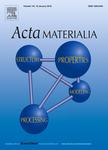版权所有:内蒙古大学图书馆 技术提供:维普资讯• 智图
内蒙古自治区呼和浩特市赛罕区大学西街235号 邮编: 010021

作者机构:Harbin Inst Technol State Key Lab Precis Welding &Joining Mat & Struct Harbin 150001 Peoples R China Harbin Inst Technol Zhengzhou Res Inst Zhengzhou 450046 Peoples R China
出 版 物:《ACTA MATERIALIA》 (Acta Mater)
年 卷 期:2025年第286卷
核心收录:
学科分类:0806[工学-冶金工程] 08[工学] 0805[工学-材料科学与工程(可授工学、理学学位)]
基 金:National Natural Science Foundation of China [52305345 52175301 52205350]
主 题:CU-Mo alloys Compressive stress Surface mechanical treatment Density function theory Hydrogen evolution reaction
摘 要:Guided by the Sabatier volcano principle, we designed a severe plastic deformation-based strategy to obtain high-performance metallic electrocatalysts with boosted hydrogen evolution activity. Cu-Mo system was selected due to their opposite Gibbs free energies of adsorbed hydrogen and surface mechanical treatment was utilized to fine-tune the adsorption energy. A surface compressive stress layer with high values of -464+37 MPa was realized under the cryogenic severe plastic deformation process. The treated metallic catalysts exhibit ultra-low overpotential (79+3 mV at 10 mA cm-2 at the alkaline condition and 31+2 mV at 10 mA cm-2 at the acidic condition). The effective Tafel slope of acidic hydrogen evolution treated in the cryogenic environment is 141.2 mV decade-1, showing a fast Tafel-dominated Volmer-Tafel reaction mechanism. The density function theory calculation showed a transformation of the hydrogen adsorption site with increased external compressive stress, which contributed to the adsorption site adjacent to the supersaturated solid solution Mo atom. Bader charge analyses showed that the Mo atom lost more electrons, causing the surrounding Cu atoms to enter a stronger electronegative state, which significantly enhanced the adsorption capacity of Cu atoms for hydrogen with nearzero adsorption energy.